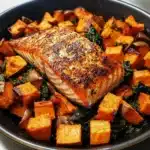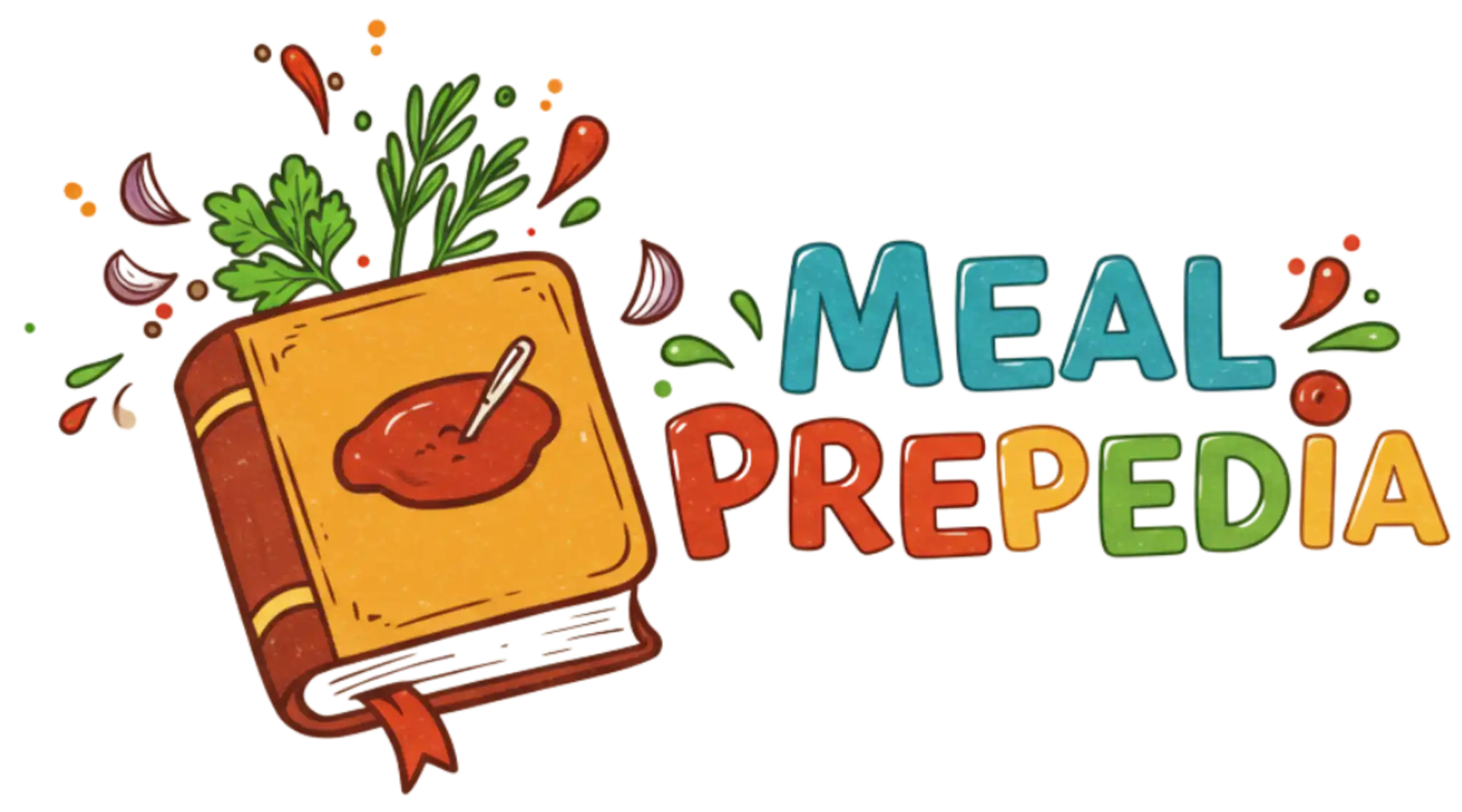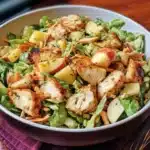This Roasted Salmon with Sweet Potatoes recipe has become an absolute staple in our household, a true knight in shining armor on busy weeknights when I’m craving something both incredibly delicious and genuinely nourishing. The first time I made it, I was a little skeptical – could something so simple truly be that good? The aroma that filled the kitchen as the salmon and sweet potatoes roasted to perfection was the first clue. Then came the taste test. My husband, usually a man of few words when it comes to food unless it’s truly exceptional, took one bite and his eyes widened. “This is amazing,” he declared, a sentiment echoed by my kids who, surprisingly, devoured their sweet potatoes without a single complaint. The magic lies in the combination of flaky, rich salmon, caramelized and tender sweet potatoes, and the subtle blend of herbs and spices that tie it all together. It’s a sheet pan wonder that minimizes cleanup, maximizes flavor, and leaves everyone at the table feeling satisfied and happy. It’s not just a meal; it’s an experience – one that proves healthy eating can be utterly delightful and effortlessly chic.
Ingredients
- Salmon Fillets: 4 (6-ounce) skin-on or skinless salmon fillets, about 1-1.5 inches thick. These provide the rich, flaky protein base for our dish, packed with omega-3 fatty acids.
- Sweet Potatoes: 2 large (about 1.5-2 lbs total), peeled and diced into 1-inch cubes. Their natural sweetness caramelizes beautifully when roasted, offering a wonderful contrast to the savory salmon and a great source of Vitamin A.
- Olive Oil: 1/4 cup, extra virgin, plus more for drizzling. Essential for roasting, it helps the sweet potatoes crisp up and keeps the salmon moist, while adding healthy fats.
- Garlic Powder: 1 teaspoon. Adds a mellow, savory depth that complements both the salmon and sweet potatoes without the risk of burning fresh garlic.
- Dried Oregano: 1 teaspoon. Lends a classic Mediterranean herbaceous note that pairs wonderfully with fish and root vegetables.
- Dried Thyme: 1/2 teaspoon. Offers an earthy, slightly floral aroma that enhances the overall savory profile.
- Smoked Paprika: 1/2 teaspoon (optional, but recommended). Gives a subtle smoky flavor and beautiful color to the dish.
- Salt: 1 teaspoon, coarse sea salt or kosher salt, divided. Crucial for enhancing all the flavors; adjust to your preference.
- Black Pepper: 1/2 teaspoon, freshly ground, divided. Provides a gentle warmth and balances the richness of the salmon.
- Lemon: 1, cut into wedges, for serving. A fresh squeeze of lemon juice at the end brightens all the flavors and cuts through the richness.
- Fresh Parsley or Dill: 2 tablespoons, chopped, for garnish (optional). Adds a touch of freshness and visual appeal upon serving.
Instructions
- Preheat and Prepare: Preheat your oven to 400°F (200°C). Line a large, rimmed baking sheet with parchment paper for easy cleanup. If you don’t have parchment paper, lightly grease the baking sheet.
- Prepare Sweet Potatoes: In a large bowl, add the diced sweet potatoes. Drizzle with 2 tablespoons of the olive oil. Sprinkle with half the garlic powder (1/2 tsp), half the dried oregano (1/2 tsp), half the dried thyme (1/4 tsp), half the smoked paprika (1/4 tsp, if using), 1/2 teaspoon of salt, and 1/4 teaspoon of black pepper. Toss thoroughly to ensure the sweet potatoes are evenly coated.
- Roast Sweet Potatoes (First Stage): Spread the seasoned sweet potatoes in a single layer on one side of the prepared baking sheet. Ensure they are not overcrowded, as this will cause them to steam rather than roast. Roast for 15 minutes. This initial roasting time gives the sweet potatoes a head start, as they take longer to cook than the salmon.
- Prepare Salmon: While the sweet potatoes are roasting, prepare the salmon. Pat the salmon fillets dry with a paper towel – this helps the skin get crispier (if using skin-on) and allows the seasoning to adhere better.
- Season Salmon: Place the salmon fillets in the same bowl you used for the sweet potatoes (no need to wash). Drizzle with the remaining 2 tablespoons of olive oil. Sprinkle the tops of the salmon fillets evenly with the remaining garlic powder (1/2 tsp), dried oregano (1/2 tsp), dried thyme (1/4 tsp), smoked paprika (1/4 tsp, if using), 1/2 teaspoon of salt, and 1/4 teaspoon of black pepper. Gently rub the seasonings into the flesh of the salmon.
- Add Salmon to Baking Sheet: After the sweet potatoes have roasted for 15 minutes, carefully remove the baking sheet from the oven. Push the sweet potatoes to one side if they’ve spread out, and arrange the seasoned salmon fillets on the other side of the baking sheet, ensuring there’s a little space between each fillet.
- Roast Together: Return the baking sheet to the oven. Roast for another 12-18 minutes, depending on the thickness of your salmon fillets and your desired level of doneness. The salmon is cooked when it flakes easily with a fork and reaches an internal temperature of 135-140°F (57-60°C) for medium, or up to 145°F (63°C) for well-done. The sweet potatoes should be tender and slightly caramelized at the edges.
- Rest and Serve: Once cooked, carefully remove the baking sheet from the oven. Let the salmon rest for a few minutes before serving. This allows the juices to redistribute, resulting in more tender and flavorful fish.
- Garnish and Serve: Serve the roasted salmon fillets and sweet potatoes immediately. Garnish with fresh chopped parsley or dill, if desired, and serve with lemon wedges on the side for squeezing over the salmon.
Nutrition Facts
- Servings: 4
- Calories per serving: Approximately 550-650 calories. This range can vary based on the exact size of the salmon fillets and sweet potatoes.
- Protein: Approximately 40-45g. Primarily from the salmon, essential for muscle repair, immune function, and satiety.
- Healthy Fats (Omega-3s): Approximately 25-30g total fat, with a significant portion being heart-healthy monounsaturated fats from olive oil and polyunsaturated omega-3 fatty acids from salmon. Omega-3s are crucial for brain health and reducing inflammation.
- Vitamin A: Over 100% of the Daily Value. Mainly from the sweet potatoes, vital for vision, immune function, and skin health.
- Fiber: Approximately 7-9g. Contributed by the sweet potatoes, aiding in digestion, promoting fullness, and helping to regulate blood sugar levels.
Preparation Time
- Total Preparation Time: Approximately 45-55 minutes
- Prep Time: 15-20 minutes (peeling and dicing sweet potatoes, seasoning ingredients).
- Cook Time: 30-35 minutes (15 minutes for sweet potatoes alone, then 15-20 minutes with salmon).
- This recipe is designed for efficiency, making it an excellent choice for a weeknight meal where time is of the essence but quality and flavor are not to be compromised.
How to Serve
This Roasted Salmon with Sweet Potatoes is a wonderfully complete meal on its own, but here are some delightful ways to serve and enhance it:
- Simple and Elegant:
- Serve directly from the sheet pan for a rustic family-style meal, or plate individually for a more refined presentation.
- Place a salmon fillet alongside a generous portion of roasted sweet potatoes.
- Must-have: Always include lemon wedges on the side. A fresh squeeze of lemon juice right before eating brightens all the flavors immeasurably.
- Garnish: Sprinkle with fresh chopped parsley, dill, or chives for a pop of color and fresh herbal notes.
- With a Green Side:
- Simple Green Salad: A light salad with a vinaigrette dressing (lemon-tahini, balsamic, or a simple olive oil and red wine vinegar) balances the richness of the salmon. Think mixed greens, cherry tomatoes, and cucumber.
- Steamed or Roasted Asparagus: Asparagus spears roasted alongside the salmon and sweet potatoes (add them in the last 10-12 minutes of cooking) or quickly steamed make a perfect green companion.
- Sautéed Spinach or Kale: Quickly wilted greens with a touch of garlic offer an extra dose of nutrients and color.
- Add a Sauce:
- Yogurt-Dill Sauce: Mix plain Greek yogurt with chopped fresh dill, a squeeze of lemon juice, a minced garlic clove (optional), and a pinch of salt and pepper. This creamy, tangy sauce is divine with salmon.
- Tahini Dressing: Whisk tahini with lemon juice, water (to thin), minced garlic, and salt for a nutty, creamy drizzle.
- Pesto: A dollop of store-bought or homemade pesto can add an intense burst of basil and pine nut flavor.
- With Grains (for a heartier meal):
- Quinoa: Serve the salmon and sweet potatoes over a bed of fluffy quinoa for added protein and fiber.
- Couscous: Lemon-herb couscous would complement the flavors beautifully.
- Brown Rice: A simple side of brown rice makes the meal even more substantial.
- For Guests:
- Arrange attractively on a platter, garnishing generously.
- Offer a selection of the sauces mentioned above in small bowls.
- Pair with a crisp white wine like Sauvignon Blanc or Pinot Grigio.
Additional Tips
- Don’t Overcrowd the Pan: This is key for achieving nicely roasted, slightly crispy sweet potatoes rather than steamed ones. If your baking sheet isn’t large enough, use two separate sheets. Give the sweet potatoes and salmon enough space for the hot air to circulate.
- Uniform Sweet Potato Size: Cut your sweet potatoes into roughly equal 1-inch cubes. This ensures they cook evenly, so you don’t end up with some pieces burnt and others undercooked.
- Check Salmon Doneness Accurately: The best way to check salmon for doneness is with an instant-read thermometer. Insert it into the thickest part of the fillet. Aim for 135-140°F (57-60°C) for medium (still slightly pink and moist in the center) or 145°F (63°C) if you prefer it more cooked through. You can also check by seeing if it flakes easily with a fork. Be careful not to overcook, as salmon can dry out quickly.
- Skin-On vs. Skinless Salmon: If using skin-on salmon, you can place it skin-side down on the baking sheet. The skin can help protect the fillet from drying out and can get delightfully crispy if your pan is hot enough and lightly oiled. If you prefer, the skin can be easily removed after cooking.
- Flavor Variations: Feel free to experiment with seasonings.
- Spicy Kick: Add 1/4 to 1/2 teaspoon of red pepper flakes to the sweet potatoes or salmon.
- Herbs de Provence: A lovely alternative to the oregano and thyme.
- Maple-Glazed: For a touch more sweetness, drizzle a teaspoon of maple syrup over each salmon fillet during the last 5 minutes of roasting.
- Garlic Lovers: Tuck a few whole, unpeeled garlic cloves amongst the sweet potatoes; they’ll roast to sweet, creamy perfection.
- Parchment Paper is Your Friend: Using parchment paper not only prevents sticking but also makes cleanup incredibly easy. Simply discard the parchment paper after cooking.
- Meal Prep Option: You can chop the sweet potatoes a day or two in advance and store them in an airtight container in the refrigerator. You can also mix the dry spices together ahead of time. This cuts down on prep time on the day of cooking.
- Using Other Vegetables: While sweet potatoes are fantastic, feel free to substitute or add other sturdy vegetables that roast well. Chunks of broccoli, cauliflower florets, bell pepper strips, or Brussels sprouts (halved) can be added. Adjust roasting time as needed; denser vegetables like carrots or regular potatoes might need the same initial 15-minute roast as sweet potatoes, while broccoli might only need the last 15-20 minutes with the salmon.
FAQ Section
- Q: Can I use frozen salmon fillets for this recipe?
A: Yes, you can use frozen salmon fillets. It’s best to thaw them completely in the refrigerator overnight before using. Pat them very dry with paper towels before seasoning and roasting, as excess moisture can prevent them from searing nicely and make them steam. If you’re in a pinch, some people roast from frozen, but it will require a longer cooking time and the texture might not be as optimal. - Q: How do I know when the salmon is perfectly cooked?
A: The most reliable way is to use an instant-read food thermometer. Insert it into the thickest part of the fillet. For medium, slightly pink salmon, aim for an internal temperature of 135-140°F (57-60°C). For well-done, aim for 145°F (63°C). Visually, the salmon should be opaque and flake easily with a fork. Be careful not to overcook it, as it can become dry. - Q: Can I use other types of potatoes instead of sweet potatoes?
A: Absolutely! Yukon Gold, red potatoes, or even Russet potatoes (cut into similar-sized cubes) would work well. They might require a slightly different roasting time; Yukon Golds and red potatoes might cook a bit quicker than dense Russets or sweet potatoes, so keep an eye on them. The flavor profile will change, but it will still be delicious. - Q: What’s the best way to store and reheat leftovers?
A: Store leftover roasted salmon and sweet potatoes in an airtight container in the refrigerator for up to 2-3 days. To reheat, you can use the microwave (though salmon can sometimes get a bit dry), or better yet, reheat gently in a preheated oven at 300°F (150°C) for about 10-15 minutes, or until warmed through. You can also enjoy the leftovers cold, perhaps flaked into a salad. - Q: Is this recipe considered healthy?
A: Yes, this recipe is very healthy! Salmon is packed with omega-3 fatty acids, high-quality protein, and B vitamins. Sweet potatoes are an excellent source of Vitamin A, Vitamin C, manganese, and fiber. The use of olive oil adds healthy monounsaturated fats. It’s a well-balanced meal providing essential nutrients. - Q: Can I make this recipe if I don’t have all the specific dried herbs listed?
A: Certainly! While oregano and thyme are a classic combination, you can substitute with other dried herbs you enjoy. Italian seasoning blend would work well, or even just garlic powder, salt, and pepper with a good squeeze of lemon will still be tasty. Fresh herbs like rosemary or dill can also be used (add fresh herbs towards the end of cooking or as a garnish, as they can burn if roasted for too long). - Q: My sweet potatoes sometimes burn before they are tender. How can I prevent this?
A: There are a few reasons this might happen. Ensure your oven temperature is accurate (some ovens run hot). Make sure the sweet potatoes are cut into uniform, not-too-small pieces (about 1-inch cubes are ideal). Ensure they are well-coated in oil, as this protects them. If they start to brown too quickly, you can gently toss them midway through their initial 15-minute roast or lower the oven temperature slightly. Also, avoid using the top rack if your oven has a very strong top heating element. - Q: Can I prepare any components of this dish ahead of time?
A: Yes, to save time, you can peel and chop the sweet potatoes up to a day in advance; store them in an airtight container in the refrigerator (some people submerge them in water to prevent browning, then drain and dry well before use). You can also pre-mix your dry spice blend. However, it’s best to season and roast the salmon just before you plan to eat it for the freshest taste and best texture.

Roasted Salmon with Sweet Potatoes
Ingredients
- Salmon Fillets: 4 (6-ounce) skin-on or skinless salmon fillets, about 1-1.5 inches thick. These provide the rich, flaky protein base for our dish, packed with omega-3 fatty acids.
- Sweet Potatoes: 2 large (about 1.5-2 lbs total), peeled and diced into 1-inch cubes. Their natural sweetness caramelizes beautifully when roasted, offering a wonderful contrast to the savory salmon and a great source of Vitamin A.
- Olive Oil: 1/4 cup, extra virgin, plus more for drizzling. Essential for roasting, it helps the sweet potatoes crisp up and keeps the salmon moist, while adding healthy fats.
- Garlic Powder: 1 teaspoon. Adds a mellow, savory depth that complements both the salmon and sweet potatoes without the risk of burning fresh garlic.
- Dried Oregano: 1 teaspoon. Lends a classic Mediterranean herbaceous note that pairs wonderfully with fish and root vegetables.
- Dried Thyme: 1/2 teaspoon. Offers an earthy, slightly floral aroma that enhances the overall savory profile.
- Smoked Paprika: 1/2 teaspoon (optional, but recommended). Gives a subtle smoky flavor and beautiful color to the dish.
- Salt: 1 teaspoon, coarse sea salt or kosher salt, divided. Crucial for enhancing all the flavors; adjust to your preference.
- Black Pepper: 1/2 teaspoon, freshly ground, divided. Provides a gentle warmth and balances the richness of the salmon.
- Lemon: 1, cut into wedges, for serving. A fresh squeeze of lemon juice at the end brightens all the flavors and cuts through the richness.
- Fresh Parsley or Dill: 2 tablespoons, chopped, for garnish (optional). Adds a touch of freshness and visual appeal upon serving.
Instructions
- Preheat and Prepare: Preheat your oven to 400°F (200°C). Line a large, rimmed baking sheet with parchment paper for easy cleanup. If you don’t have parchment paper, lightly grease the baking sheet.
- Prepare Sweet Potatoes: In a large bowl, add the diced sweet potatoes. Drizzle with 2 tablespoons of the olive oil. Sprinkle with half the garlic powder (1/2 tsp), half the dried oregano (1/2 tsp), half the dried thyme (1/4 tsp), half the smoked paprika (1/4 tsp, if using), 1/2 teaspoon of salt, and 1/4 teaspoon of black pepper. Toss thoroughly to ensure the sweet potatoes are evenly coated.
- Roast Sweet Potatoes (First Stage): Spread the seasoned sweet potatoes in a single layer on one side of the prepared baking sheet. Ensure they are not overcrowded, as this will cause them to steam rather than roast. Roast for 15 minutes. This initial roasting time gives the sweet potatoes a head start, as they take longer to cook than the salmon.
- Prepare Salmon: While the sweet potatoes are roasting, prepare the salmon. Pat the salmon fillets dry with a paper towel – this helps the skin get crispier (if using skin-on) and allows the seasoning to adhere better.
- Season Salmon: Place the salmon fillets in the same bowl you used for the sweet potatoes (no need to wash). Drizzle with the remaining 2 tablespoons of olive oil. Sprinkle the tops of the salmon fillets evenly with the remaining garlic powder (1/2 tsp), dried oregano (1/2 tsp), dried thyme (1/4 tsp), smoked paprika (1/4 tsp, if using), 1/2 teaspoon of salt, and 1/4 teaspoon of black pepper. Gently rub the seasonings into the flesh of the salmon.
- Add Salmon to Baking Sheet: After the sweet potatoes have roasted for 15 minutes, carefully remove the baking sheet from the oven. Push the sweet potatoes to one side if they’ve spread out, and arrange the seasoned salmon fillets on the other side of the baking sheet, ensuring there’s a little space between each fillet.
- Roast Together: Return the baking sheet to the oven. Roast for another 12-18 minutes, depending on the thickness of your salmon fillets and your desired level of doneness. The salmon is cooked when it flakes easily with a fork and reaches an internal temperature of 135-140°F (57-60°C) for medium, or up to 145°F (63°C) for well-done. The sweet potatoes should be tender and slightly caramelized at the edges.
- Rest and Serve: Once cooked, carefully remove the baking sheet from the oven. Let the salmon rest for a few minutes before serving. This allows the juices to redistribute, resulting in more tender and flavorful fish.
- Garnish and Serve: Serve the roasted salmon fillets and sweet potatoes immediately. Garnish with fresh chopped parsley or dill, if desired, and serve with lemon wedges on the side for squeezing over the salmon.
Nutrition
- Serving Size: one normal portion
- Calories: 650
- Fat: 30g
- Protein: 45g






